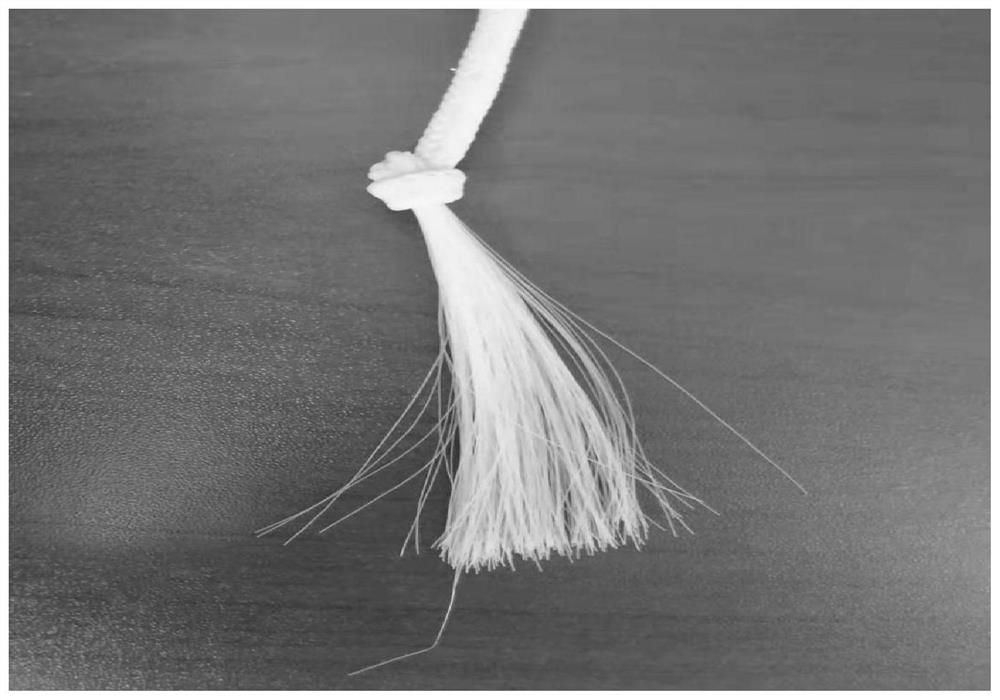Biodegradable spinning material and preparation method and application thereof
A spinning material and biodegradation technology, applied in the field of nonwoven materials, can solve the problems of low use efficiency, uncontrollable degradation speed, unstable dyeing performance and other problems of disposable products, and achieve good degradation performance and mechanical properties, good biophase Effect of capacitive, good degradability and mechanical properties
- Summary
- Abstract
- Description
- Claims
- Application Information
AI Technical Summary
Problems solved by technology
Method used
Image
Examples
preparation example Construction
[0051] The preparation of the chemically modified PBAT comprises the following steps:
[0052] (1) Mix adipic acid, 1,4-butanediol and a new chain extender to carry out an esterification reaction to obtain an esterification system; the new chain extender includes 1,4-cyclohexanedicarboxylic acid Dimethyl ester, trimethylolpropane triglycidyl ether and trans-methyl 9,10-epoxyoctadecanoate, the dimethyl 1,4-cyclohexanedicarboxylate, trimethylol The molar ratio of propane triglycidyl ether to trans-9,10-epoxyoctadecanoic acid methyl ester is 1:1:0.5;
[0053] (2) Add dimethyl terephthalate, dimethyl isophthalate-5-sodium sulfonate, 1,4-butanediol and the first titanium series catalyst to the esterification system to carry out transesterification , to obtain a transesterification system;
[0054] (3) adding a second titanium-based catalyst and a stabilizer to the transesterification system, and performing a polycondensation reaction under vacuum conditions to obtain chemically m...
Embodiment 1
[0129] (1) The preparation process of chemically modified PBAT is as follows:
[0130] Esterification stage: Add 1,314g of adipic acid and 1,000g of 1,4-butanediol into a 10-liter polycondensation reactor respectively, start heating, and add 7.14g of new-type chain extension supplement (the new-type Chain extenders include dimethyl 1,4-cyclohexanedicarboxylate, trimethylolpropane triglycidyl ether, and methyl trans-9,10-epoxyoctadecanoate, the 1,4 -The molar ratio of dimethyl cyclohexanedicarboxylate, trimethylolpropane triglycidyl ether and trans-9,10-epoxy octadecanoic acid methyl ester is 1:1:0.5), and the temperature is continuously increased and Keep at 150-160°C for normal pressure esterification dehydration reaction, measure the acid value under 320g of water output to be 0.04, and the reaction time is 2 hours, which is the end point of the reaction;
[0131] Transesterification stage: after the esterification reaction finishes, first add dimethyl terephthalate, dimeth...
Embodiment 2
[0153] (1) The preparation process of chemically modified PBAT is as follows:
[0154] Esterification stage: Add 1,314g of adipic acid and 1,000g of 1,4-butanediol into a 10-liter polycondensation reactor respectively, start heating, and add 3.27g of new-type chain extender after stirring evenly (the new type Chain extenders include dimethyl 1,4-cyclohexanedicarboxylate, trimethylolpropane triglycidyl ether, and methyl trans-9,10-epoxyoctadecanoate, the 1,4 -The molar ratio of dimethyl cyclohexanedicarboxylate, trimethylolpropane triglycidyl ether and trans-9,10-epoxy octadecanoic acid methyl ester is 1:1:0.5), and the temperature is continuously increased and Keep at 150-160°C for normal pressure esterification dehydration reaction, measure the acid value of 0.03 under 388g of water output, and the reaction time is 3 hours, which is the reaction end point;
[0155] Transesterification stage: After the esterification reaction is over, fix an esterification reaction node and c...
PUM
| Property | Measurement | Unit |
|---|---|---|
| Granularity | aaaaa | aaaaa |
| Diameter | aaaaa | aaaaa |
| Diameter | aaaaa | aaaaa |
Abstract
Description
Claims
Application Information
 Login to View More
Login to View More - R&D
- Intellectual Property
- Life Sciences
- Materials
- Tech Scout
- Unparalleled Data Quality
- Higher Quality Content
- 60% Fewer Hallucinations
Browse by: Latest US Patents, China's latest patents, Technical Efficacy Thesaurus, Application Domain, Technology Topic, Popular Technical Reports.
© 2025 PatSnap. All rights reserved.Legal|Privacy policy|Modern Slavery Act Transparency Statement|Sitemap|About US| Contact US: help@patsnap.com



